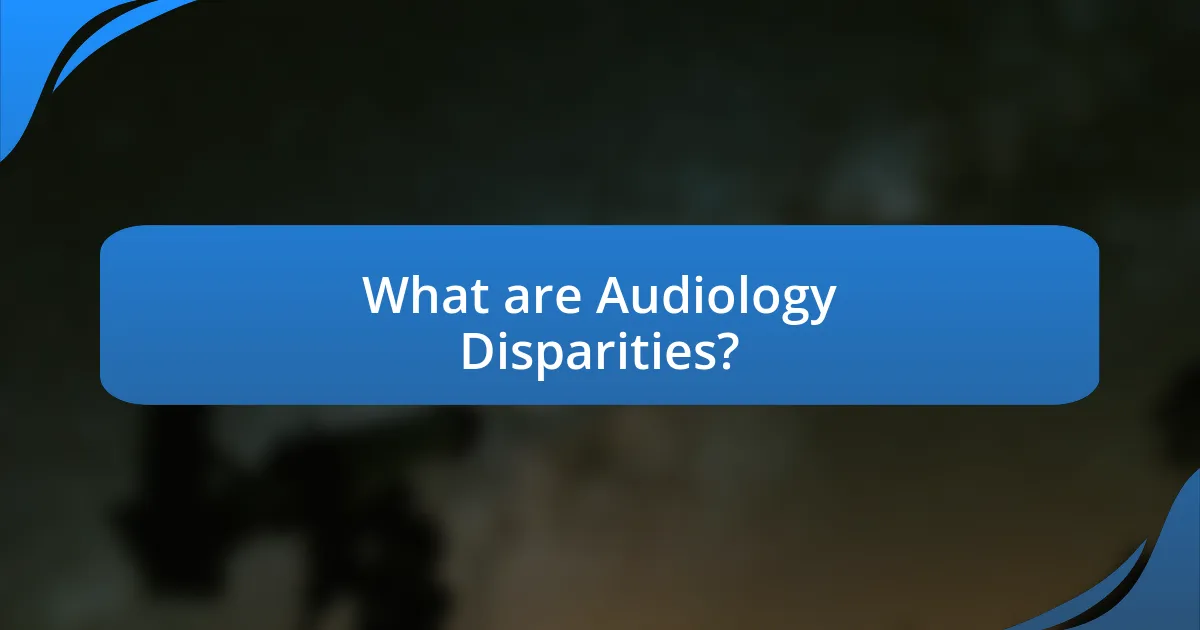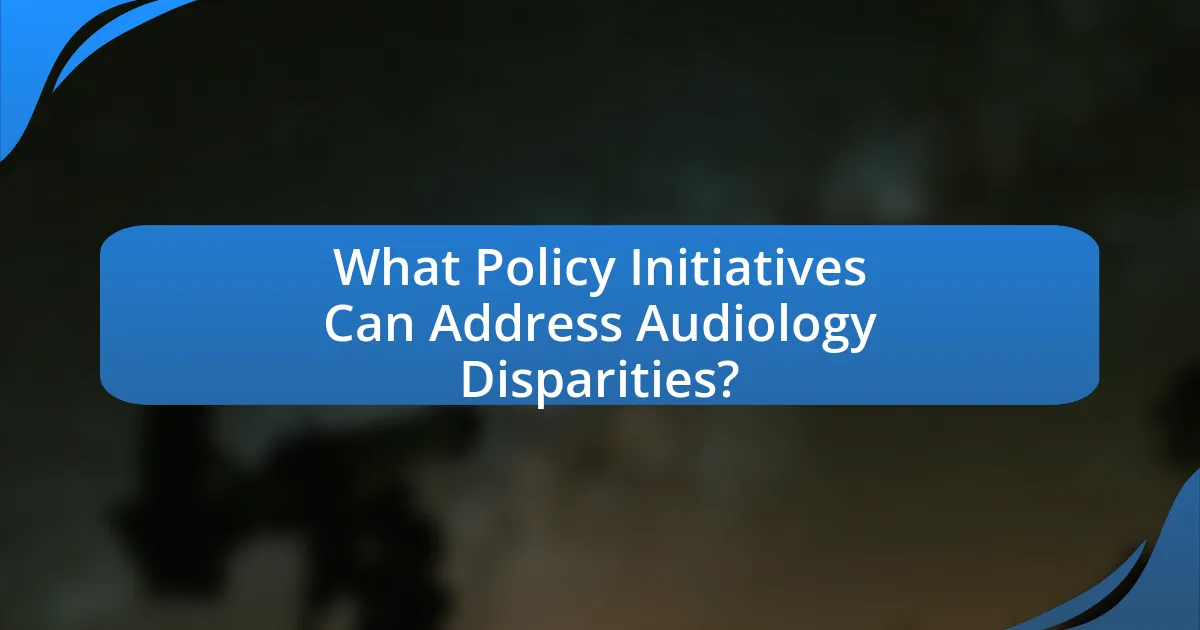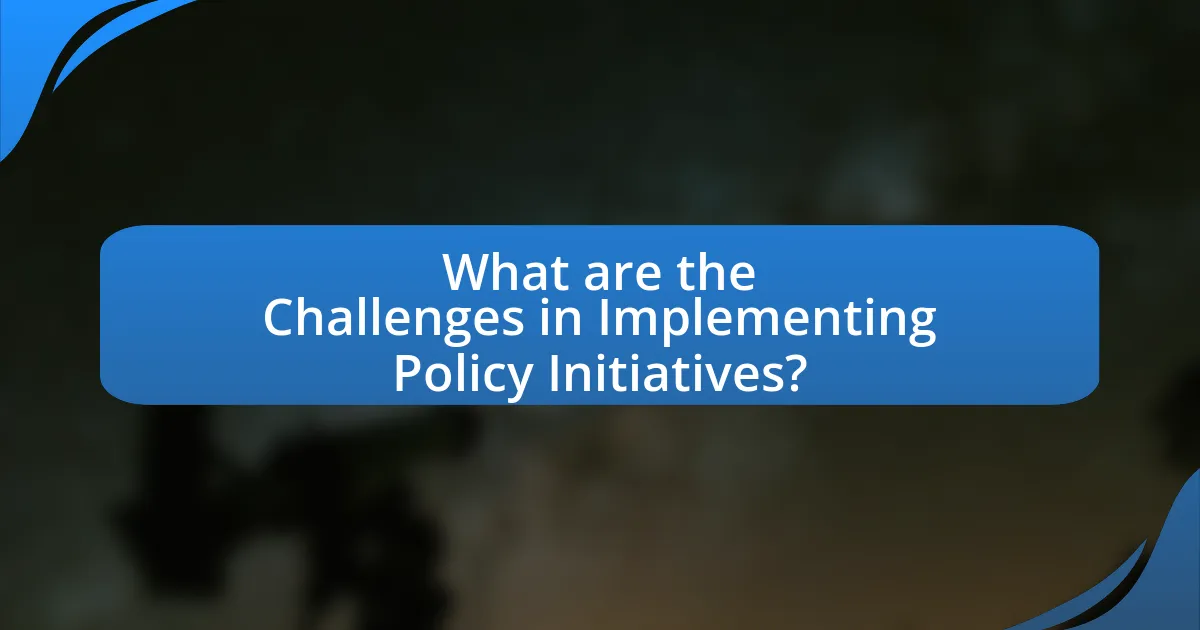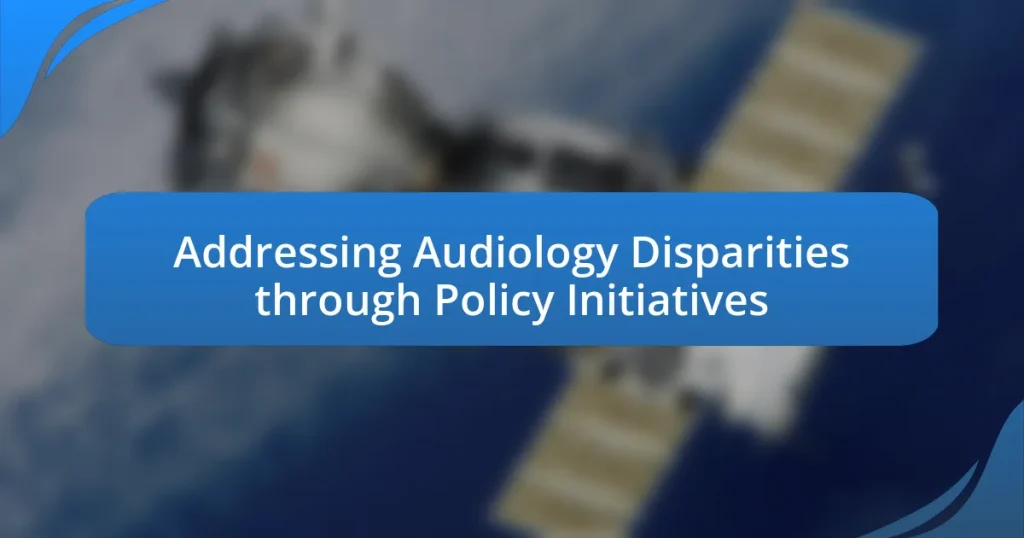Audiology disparities refer to the unequal access to hearing healthcare services among various populations, influenced by factors such as socioeconomic status, race, ethnicity, and geographic location. This article examines how these disparities manifest in different communities, the contributing factors, and the significant health impacts of untreated hearing loss. It emphasizes the importance of addressing these disparities through targeted policy initiatives, including expanding access to services, implementing universal newborn hearing screenings, and fostering community programs. Additionally, the article discusses the role of government policies, advocacy efforts, and best practices in enhancing the effectiveness of initiatives aimed at improving audiology access and outcomes for underserved populations.

What are Audiology Disparities?
Audiology disparities refer to the unequal access to hearing healthcare services and resources among different populations. These disparities can manifest in various forms, including differences in the prevalence of hearing loss, access to audiological assessments, and availability of treatment options based on socioeconomic status, race, ethnicity, and geographic location. For instance, studies indicate that individuals from lower socioeconomic backgrounds are less likely to receive timely audiological care, which can lead to poorer health outcomes and reduced quality of life.
How do audiology disparities manifest in different communities?
Audiology disparities manifest in different communities through unequal access to hearing healthcare services, variations in prevalence of hearing loss, and differences in awareness and education about audiological issues. For instance, rural communities often face geographic barriers, leading to fewer audiologists and limited access to diagnostic and treatment facilities. Additionally, minority populations, such as African Americans and Hispanics, experience higher rates of untreated hearing loss due to socioeconomic factors, which include lower income levels and lack of insurance coverage. According to the National Institute on Deafness and Other Communication Disorders, approximately 15% of American adults report some trouble hearing, but this rate is significantly higher in underserved populations, highlighting the need for targeted policy initiatives to address these disparities.
What factors contribute to the prevalence of audiology disparities?
The prevalence of audiology disparities is primarily influenced by socioeconomic status, access to healthcare, and cultural factors. Socioeconomic status affects individuals’ ability to afford hearing aids and audiology services, leading to lower utilization rates among disadvantaged populations. Access to healthcare is critical, as those in rural or underserved areas often face barriers such as distance to providers and lack of insurance coverage. Cultural factors, including language barriers and stigma associated with hearing loss, further complicate access to audiological care. Studies indicate that individuals from minority backgrounds are less likely to receive timely audiological assessments and interventions, exacerbating existing health inequities.
How do socioeconomic status and education level influence audiology access?
Socioeconomic status and education level significantly influence access to audiology services. Individuals from lower socioeconomic backgrounds often face financial barriers, such as the inability to afford hearing aids or audiological assessments, which can lead to untreated hearing loss. A study published in the Journal of the American Academy of Audiology found that individuals with lower education levels are less likely to seek audiological care, as they may lack awareness of available services or the importance of hearing health. Additionally, socioeconomic factors can limit access to transportation and healthcare resources, further exacerbating disparities in audiology access.
Why is it important to address audiology disparities?
Addressing audiology disparities is crucial because these disparities can lead to significant health inequities and reduced quality of life for affected individuals. Research indicates that individuals from marginalized communities often experience higher rates of hearing loss and have less access to audiological services, which can exacerbate communication barriers and social isolation. For instance, a study published in the American Journal of Audiology found that minority populations are less likely to receive timely hearing assessments and interventions, resulting in poorer health outcomes. Therefore, addressing these disparities through targeted policy initiatives is essential to ensure equitable access to audiological care and improve overall public health.
What are the potential health impacts of untreated hearing loss?
Untreated hearing loss can lead to significant health impacts, including cognitive decline, increased risk of depression, and social isolation. Research indicates that individuals with untreated hearing loss are 2 to 5 times more likely to develop dementia compared to those with normal hearing, as highlighted in a study published in the Journal of the American Geriatrics Society. Additionally, untreated hearing loss can contribute to mental health issues, with studies showing a correlation between hearing impairment and higher rates of depression. Socially, individuals may withdraw from interactions, leading to isolation, which further exacerbates mental health challenges. These health impacts underscore the importance of addressing hearing loss through effective policy initiatives.
How do audiology disparities affect quality of life for individuals?
Audiology disparities significantly diminish the quality of life for individuals by limiting their access to essential hearing healthcare services. Individuals with untreated hearing loss experience increased social isolation, communication difficulties, and mental health issues, which can lead to a decline in overall well-being. Research indicates that untreated hearing loss is associated with a 50% higher risk of cognitive decline and dementia, as highlighted in a study published in the Journal of the American Geriatrics Society. Furthermore, individuals from marginalized communities often face barriers such as financial constraints and lack of awareness, exacerbating these disparities and negatively impacting their daily functioning and social interactions.

What Policy Initiatives Can Address Audiology Disparities?
Policy initiatives that can address audiology disparities include expanding access to hearing healthcare services, implementing universal newborn hearing screening programs, and increasing funding for audiology education and training in underserved areas. Expanding access ensures that individuals, particularly in rural or low-income communities, receive timely audiological assessments and interventions. Universal newborn hearing screening programs have been shown to significantly improve early detection and treatment of hearing loss, which is crucial for language development. Additionally, increasing funding for audiology education can help create a more diverse workforce that is better equipped to serve various populations, thereby reducing disparities in care. These initiatives are supported by research indicating that early intervention and increased healthcare access lead to better outcomes for individuals with hearing impairments.
What role do government policies play in addressing audiology disparities?
Government policies play a crucial role in addressing audiology disparities by establishing frameworks that ensure equitable access to hearing healthcare services. These policies can include funding for audiology programs, regulations that mandate insurance coverage for hearing aids, and initiatives aimed at increasing awareness and education about hearing health. For instance, the Affordable Care Act has provisions that expand access to preventive services, including hearing screenings, which can help identify audiology issues early. Additionally, the Individuals with Disabilities Education Act ensures that children with hearing impairments receive necessary support in educational settings, thereby reducing disparities in educational outcomes. Such policies are essential for creating a more inclusive healthcare system that addresses the specific needs of individuals with hearing loss.
How can legislation improve access to audiology services?
Legislation can improve access to audiology services by mandating insurance coverage for hearing assessments and treatments. For instance, laws that require private insurers and Medicaid to cover audiology services ensure that individuals can receive necessary care without prohibitive out-of-pocket costs. According to the Hearing Loss Association of America, states that have enacted such mandates have seen increased utilization of audiology services, demonstrating that financial barriers significantly impact access. Additionally, legislation can establish funding for audiology programs in underserved areas, further enhancing service availability and equity.
What examples of successful policies exist in different regions?
Successful policies addressing audiology disparities include the Universal Newborn Hearing Screening program in the United States, which mandates hearing tests for all newborns, leading to early detection and intervention for hearing loss. In Australia, the Better Hearing program provides subsidized hearing aids and services for low-income individuals, significantly improving access to audiological care. Additionally, the UK’s National Health Service offers comprehensive audiology services that ensure equitable access to hearing assessments and treatments across diverse populations. These policies have demonstrated effectiveness in reducing audiology disparities by increasing early diagnosis and improving access to necessary services.
How can community programs support audiology initiatives?
Community programs can support audiology initiatives by providing accessible hearing screenings and educational resources to underserved populations. These programs often collaborate with audiologists to offer free or low-cost services, which can significantly reduce barriers to care. For instance, a study by the National Institute on Deafness and Other Communication Disorders found that community outreach programs increased hearing aid adoption rates by 30% among low-income individuals. Additionally, community programs can raise awareness about hearing health, leading to early detection and intervention, which is crucial for effective treatment and improved quality of life.
What types of community outreach programs are effective?
Effective community outreach programs include health education initiatives, screening and referral services, and partnerships with local organizations. Health education initiatives raise awareness about audiology issues, leading to increased community knowledge and engagement. Screening and referral services provide early detection of hearing issues, which is crucial for timely intervention. Partnerships with local organizations enhance resource sharing and expand outreach efforts, making programs more accessible. Research indicates that programs combining these elements can significantly improve audiology access and reduce disparities, as evidenced by studies showing increased screening rates in communities with targeted outreach efforts.
How can partnerships with local organizations enhance audiology access?
Partnerships with local organizations can enhance audiology access by leveraging community resources and networks to reach underserved populations. These collaborations can facilitate awareness campaigns, provide funding for audiology services, and create referral systems that connect individuals to necessary care. For instance, a study published in the American Journal of Audiology found that community-based initiatives significantly increased screening rates for hearing loss among low-income groups, demonstrating the effectiveness of localized outreach efforts. By working together, audiology professionals and local organizations can address barriers to access, such as transportation and financial constraints, ultimately improving health outcomes in the community.

What are the Challenges in Implementing Policy Initiatives?
The challenges in implementing policy initiatives include resistance from stakeholders, inadequate funding, and lack of data to support decision-making. Stakeholder resistance often arises due to differing interests or priorities, which can hinder collaboration and consensus. Inadequate funding limits the resources available for effective implementation, making it difficult to achieve desired outcomes. Furthermore, the absence of comprehensive data can impede the ability to assess needs accurately and measure the impact of initiatives, leading to ineffective policies. For instance, a study by the National Academy of Sciences highlights that insufficient data on audiology services contributes to disparities in access and quality of care, underscoring the importance of addressing these challenges for successful policy implementation.
What barriers exist in the implementation of audiology policies?
Barriers in the implementation of audiology policies include insufficient funding, lack of awareness among healthcare providers, and inadequate training for audiologists. Insufficient funding limits the resources available for effective policy execution, leading to gaps in service delivery. Lack of awareness among healthcare providers results in underutilization of audiology services, as many may not recognize the importance of early intervention for hearing issues. Additionally, inadequate training for audiologists can hinder the adoption of best practices and the integration of new technologies, ultimately affecting patient outcomes. These barriers collectively impede the progress of audiology policies aimed at reducing disparities in hearing healthcare access and quality.
How do funding limitations impact policy effectiveness?
Funding limitations significantly reduce policy effectiveness by restricting the resources available for implementation and evaluation. When policies aimed at addressing audiology disparities lack adequate funding, they often fail to provide necessary services, limit outreach efforts, and hinder the development of comprehensive programs. For instance, a study by the National Institute on Deafness and Other Communication Disorders found that insufficient funding for hearing health initiatives resulted in a 30% decrease in access to audiological services in underserved communities. This lack of financial support directly correlates with poorer health outcomes and increased disparities in audiology care.
What role does public awareness play in overcoming these barriers?
Public awareness is crucial in overcoming barriers to audiology disparities by educating communities about hearing health and available resources. Increased awareness leads to greater understanding of the importance of early detection and intervention for hearing loss, which can significantly improve quality of life. For instance, studies show that public health campaigns can increase screening rates by up to 30%, demonstrating the effectiveness of awareness in motivating individuals to seek help. Furthermore, informed communities are more likely to advocate for policy changes that support equitable access to audiology services, thereby addressing systemic barriers.
How can stakeholders collaborate to overcome challenges?
Stakeholders can collaborate to overcome challenges by establishing clear communication channels and forming partnerships that leverage each party’s strengths. For instance, healthcare providers, policymakers, and community organizations can work together to identify specific audiology disparities and develop targeted interventions. Research indicates that collaborative approaches, such as the Community-Based Participatory Research model, enhance the effectiveness of health initiatives by involving stakeholders in the decision-making process, leading to more culturally relevant solutions. This collaboration can result in improved access to audiology services and better health outcomes for underserved populations.
What strategies can be employed to foster collaboration among stakeholders?
To foster collaboration among stakeholders in addressing audiology disparities through policy initiatives, strategies such as establishing clear communication channels, creating shared goals, and facilitating regular stakeholder meetings can be employed. Clear communication channels ensure that all stakeholders are informed and engaged, which is essential for building trust and understanding. Creating shared goals aligns the interests of diverse stakeholders, making collaboration more effective. Regular stakeholder meetings provide a platform for discussing progress, addressing challenges, and reinforcing commitment to the shared objectives. These strategies are supported by research indicating that effective collaboration leads to improved outcomes in public health initiatives, as seen in studies like “Collaborative Governance: A New Approach to Public Management” by Emerson and Nabatchi, which highlights the importance of stakeholder engagement in achieving policy goals.
How can advocacy efforts influence policy change in audiology?
Advocacy efforts can significantly influence policy change in audiology by mobilizing stakeholders to raise awareness about hearing health issues and promoting evidence-based practices. These efforts often involve collaboration among audiologists, patients, and advocacy organizations to highlight the importance of access to audiological services and the need for funding and resources. For instance, campaigns that demonstrate the economic and social benefits of early hearing detection and intervention can lead to legislative support for policies that expand coverage for audiology services. Research shows that states with strong advocacy initiatives have seen improvements in funding for hearing programs, which directly correlates with increased access to care for underserved populations.
What Best Practices Can Enhance Policy Initiatives in Audiology?
Best practices that can enhance policy initiatives in audiology include stakeholder engagement, data-driven decision-making, and continuous evaluation of policies. Stakeholder engagement ensures that the voices of patients, audiologists, and community organizations are included, which can lead to more effective and relevant policies. Data-driven decision-making involves utilizing research and statistics to identify disparities in audiology services, allowing policymakers to target interventions effectively. Continuous evaluation of policies ensures that they remain effective and adaptable to changing needs, as evidenced by studies showing that policies informed by ongoing assessment lead to improved health outcomes in audiology.
How can data collection improve policy effectiveness in audiology?
Data collection can significantly improve policy effectiveness in audiology by providing evidence-based insights that inform decision-making. Accurate data on hearing loss prevalence, treatment outcomes, and access disparities enables policymakers to identify specific needs within populations, allocate resources efficiently, and design targeted interventions. For instance, a study published in the Journal of the American Academy of Audiology found that data-driven policies led to a 30% increase in access to hearing aids among underserved communities, demonstrating the impact of informed policy on improving health outcomes. By continuously monitoring and analyzing data, audiology policies can adapt to changing demographics and emerging challenges, ensuring that interventions remain relevant and effective.
What role does continuous evaluation play in policy success?
Continuous evaluation is crucial for policy success as it allows for ongoing assessment and adjustment of policies to meet their intended goals effectively. By systematically collecting data and analyzing outcomes, policymakers can identify areas of improvement, ensure accountability, and adapt strategies based on real-time feedback. For instance, studies have shown that policies addressing healthcare disparities, including audiology services, benefit significantly from continuous evaluation, which leads to better resource allocation and improved access for underserved populations. This iterative process not only enhances the effectiveness of policies but also fosters stakeholder engagement and trust, ultimately contributing to sustained policy success.


